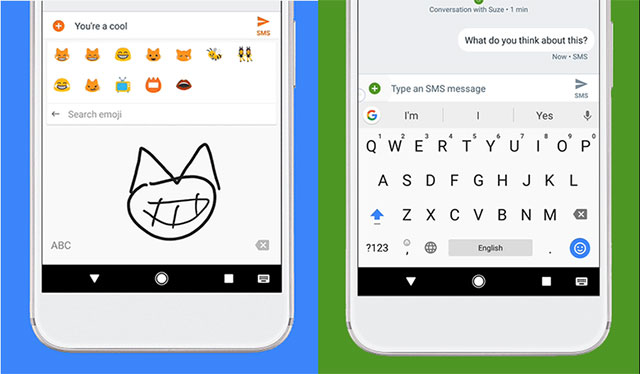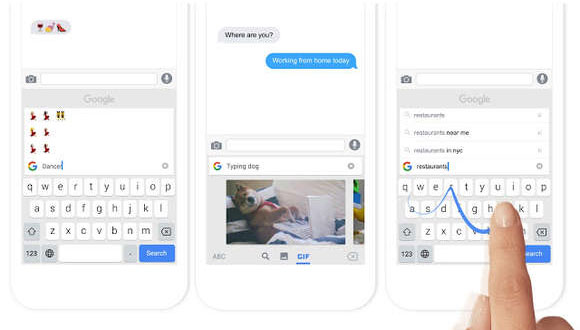Gboard's new handwriting recognition feature integrates AI, reducing errors by up to 40%
In recent times, Google is trying to improve handwriting recognition in Gboard - virtual keyboard for iOS and Android devices, through the integration of new AI systems. According to AI researchers at Google, the new artificial intelligence platform will allow this feature to be deployed faster and in particular be 20 to 40% less error-prone than the machine learning models used. used before.

- Google launches Backstory - New network security tool for businesses
'Advances in developing machine learning models have allowed researchers to create new model architectures and training methods, allowing us to modify the original approach, instead of building one. Unique model works on all input data. We launched new models for all Latin-based languages in Gboard earlier this year, 'shared two senior Google software engineers Sandro Feuz and Pedro Gonnet in a post. on personal blog.
As Feuz and Gonnet explain, most handwriting recognition systems often use touch points (touch points) to handle the sketched Latin characters. This input data is represented as a series of strokes, and these strokes will in turn contain many sequences of specific time stamped points. First, Gboard will normalize touch point coordinates to ensure they remain consistent across devices with different sampling rates and accuracy, then convert them into a series of Bézier curves (lines Parametric curves are often used in computer graphics).
The main advantage of these chains, as the two experts Feuz and Gonnet said, is that they are more compact than the series of basic input points. As for the endpoint, each curve will be represented by a polynomial (expression of variables and coefficients), determined by the starting point, endpoint and control point. For example, the word "go go" can contain 186 such points, denoted by a sequence of 4 Bézier curves for the letter 'G' (and 2 control points) and 2 curves for the letter 'O' .

- Google launched TensorFlow Lite 1.0 for mobile devices and embedded devices
These sequences will provide artificial neural networks recurrent neural (trained to recognize handwritten characters - specifically, two-dimensional versions of artificial neural networks of approximate regression (QRNN). ). This is an efficient parallelization network and therefore, provides better predictive performance. The important thing here is that QRNN will also keep the number of weights (the power of connections between mathematical functions or the nodes that make up the network) relatively small, which helps reduce file size.
So how do AI models create head or tail of curves? Specifically, by creating a matrix of columns and rows, where each column corresponds to an input curve and each row corresponds to one letter in the alphabet. Neural network outputs will be combined with character-based language models, giving rise to popular language strings and 'penalties' for uncommon and separate strings. At the same time, the sequence of touch points will be converted into shorter sequences, corresponding to a curve. Finally, the QRNN-based identifier will produce a sequence of character-related probabilities.

- Google AI application in detecting eye diseases
Gboard's handwriting recognition will run from the device to TensorFlow Lite models, a feat the group has achieved by transforming recognition models (trained in machine learning frameworks). Google TensorFlow). This allows not only reduced inference time compared to the full implementation of TensorFlow, but also helps reduce the amount of Gboard data storage.
'We will continue to further promote the implementation of this tool, beyond improving the basic Latin language language identifier. The Google team has worked hard to come up with a new model for all supported handwritten languages in Gboard ', Sandro Feuz and Pedro Gonnet share.
You should read it
- How to clear the history of the Gboard keyboard
- Translate text directly on iPhone keyboard with Gboard's Translate
- Building Neural Network to learn AI
- You can draw your own Emoji on Gboard right now
- The world's first Keycap, type text by pressing on the head
- What does handwriting reveal about your personality?
- How to type in multiple languages with Gboard on Android
- Instructions to convert Vietnamese, English Gboard keyboard
May be interested
- How to turn off Facebook face detection
 facebook can identify your face. this is interesting right? if you don't like it, check out how to turn off facebook's face recognition feature in this post!
facebook can identify your face. this is interesting right? if you don't like it, check out how to turn off facebook's face recognition feature in this post! - The Shenzhen city subway system will allow payment through face recognition feature
 futian station in shenzhen city, china is likely to become one of the first metro stations to apply face recognition technology to pay for train tickets.
futian station in shenzhen city, china is likely to become one of the first metro stations to apply face recognition technology to pay for train tickets. - Smartphone unlock feature with face recognition system makes owner lost 1,800USD while sleeping
 after pleading guilty, the perpetrator said they used yuan's face recognition system to open the phone when he was sleeping.
after pleading guilty, the perpetrator said they used yuan's face recognition system to open the phone when he was sleeping. - New face recognition technology can identify objects up to 1,000 meters away
 thanks to the great advances in the field of artificial intelligence in general and machine learning in particular in recent years, facial recognition technology is becoming much more powerful.
thanks to the great advances in the field of artificial intelligence in general and machine learning in particular in recent years, facial recognition technology is becoming much more powerful. - How does face recognition feature destroy your privacy?
 with the development at breakneck speed and too few control regulations today, does face recognition technologies put an end to personal privacy?
with the development at breakneck speed and too few control regulations today, does face recognition technologies put an end to personal privacy? - Will handwriting disappear in the digital age?
 computers, tablets and smart phones are making communication between people easier and faster. what role does handwriting play, or will it disappear in the future?
computers, tablets and smart phones are making communication between people easier and faster. what role does handwriting play, or will it disappear in the future? - It's time to face the 'reverse side' of face recognition technology
 the use of artificial intelligence ai identifies faces growing quickly. this is why you should feel anxious about your personal privacy and it's time to face the flip side of face recognition technology.
the use of artificial intelligence ai identifies faces growing quickly. this is why you should feel anxious about your personal privacy and it's time to face the flip side of face recognition technology. - Primary font, practice writing beautiful font
 primary font, practice writing beautiful font. the handwriting strokes of the students are always the most beautiful handwriting of each of us because then we are honed and molded the handwriting carefully from teachers and teachers. if you loved the handwriting, but couldn't write as well as a kid.
primary font, practice writing beautiful font. the handwriting strokes of the students are always the most beautiful handwriting of each of us because then we are honed and molded the handwriting carefully from teachers and teachers. if you loved the handwriting, but couldn't write as well as a kid. - How to enable the Undo Send feature on Microsoft Outlook?
 if you're a familiar user of gmail, you've probably heard of the undo send feature. this feature allows you to recall emails that you accidentally pressed send email. if you accidentally send an email to someone else, you can use this feature to retrieve emails. on the oulook client, microsoft also integrates this feature. however, the drawback is that this feature is buried under a variety of menus.
if you're a familiar user of gmail, you've probably heard of the undo send feature. this feature allows you to recall emails that you accidentally pressed send email. if you accidentally send an email to someone else, you can use this feature to retrieve emails. on the oulook client, microsoft also integrates this feature. however, the drawback is that this feature is buried under a variety of menus. - Instructions for sending handwriting messages on iOS 10
 the new function handwritten messages on imessgae ios 10 is a very interesting feature. we can create our own typography, or based on the handwriting patterns available to compose messages.
the new function handwritten messages on imessgae ios 10 is a very interesting feature. we can create our own typography, or based on the handwriting patterns available to compose messages.










 There are 3uTools v2.33, support for downgrade to 64-bit devices and jailbreak iOS 12
There are 3uTools v2.33, support for downgrade to 64-bit devices and jailbreak iOS 12 Want to receive security updates on Windows 7 next year, users will have to pay at least 50 USD / device
Want to receive security updates on Windows 7 next year, users will have to pay at least 50 USD / device Discover Microsoft's quietest room in the world, no one can stand for more than 45 minutes
Discover Microsoft's quietest room in the world, no one can stand for more than 45 minutes Microsoft released Windows 10 Insider Preview Build 18353, focusing on Sandbox improvements
Microsoft released Windows 10 Insider Preview Build 18353, focusing on Sandbox improvements Transfer money to Apple ID account, users will get 10% back
Transfer money to Apple ID account, users will get 10% back Microsoft released 3 new spring-themed wallpaper packs for Windows 10
Microsoft released 3 new spring-themed wallpaper packs for Windows 10